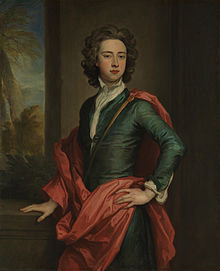Charles Beauclerk, 1st Duke of St Albans
The Duke of St Albans | |
|---|---|
 Charles Beauclerk circa 1690, on display at the Metropolitan Museum of Art. | |
| Born | 8 May 1670 |
| Died | 10 May 1726 (aged 56) Bath, England |
| Buried | Westminster Abbey |
| Noble family | Beauclerk |
| Spouse(s) | |
| Issue | Charles Beauclerk, 2nd Duke of St Albans Lady Diana Beauclerk Lord William Beauclerk Vere Beauclerk, 1st Baron Vere Lord Henry Beauclerk Lord Sidney Beauclerk Lord George Beauclerk Lord Seymour Beauclerk Lord James Beauclerk Lord Aubrey Beauclerk Lady Mary Beauclerk Lady Anne Beauclerk |
| Father | Charles II of England |
| Mother | Nell Gwyn |

Charles Beauclerk, 1st Duke of St. Albans, KG (8 May 1670 – 10 May 1726) was an illegitimate son of King Charles II of England by his mistress Nell Gwyn.
Biography
[edit]His surname, Beauclerk (Anglo-Norman for "fine scholar"), had been an epithet of King Henry I. On 21 December 1676, a warrant was passed for "a grant to Charles Beauclerc, the King's natural son, and to the heirs male of his body, of the dignities of Baron of Heddington, co. Oxford, and Earl of Burford in the same county, with remainder to his brother, James Beauclerc, and the heirs male of his body." A few weeks later, James was given "the title of Lord Beauclerc, with the place and precedence of the eldest son of an earl." Just after the death of Henry Jermyn, 1st Earl of St Albans, at the turn of the year, on 5 January 1684, King Charles granted his son Charles, Earl of Burford, the title of Duke of St Albans, gave him an allowance of £1,000 a year, and granted him the offices of Chief Ranger of Enfield Chace and Master of the Hawks in reversion (i. e. after the death of the current incumbents).[citation needed] He became colonel in the 8th regiment of horse in 1687, and served with the emperor Leopold I, being present at the siege of Belgrade in 1688.[2]
When his mother died (14 November 1687), Beauclerk received a large estate, including Burford House, near Windsor Castle. After the Battle of Landen in 1693, William III made Beauclerk captain of the gentlemen pensioners, and four years later gentleman of the bedchamber. His father had given him the reversion of the office of Hereditary Master Falconer and that of Hereditary Registrar of the Court of Chancery, which fell vacant in 1698. His Whig sentiments prevented his advancement under Queen Anne, but he was restored to favour at the accession of King George I.[2] In 1718, George made him a Knight of the Garter.
Beauclerk died at Bath two days after his 56th birthday and is buried in Westminster Abbey. He was succeeded by his eldest son.
Marriage and issue
[edit]
On 17 April 1694 he married Lady Diana de Vere, daughter and sole heiress (as her sisters died unmarried) of Aubrey de Vere, 20th Earl of Oxford. She was a well-known beauty, who became lady of the bedchamber to Caroline of Ansbach, Princess of Wales.[2] By his wife he had twelve children:
Sons
[edit]- Charles Beauclerk, 2nd Duke of St Albans (6 April 1696 – 27 July 1751), eldest son and heir;
- Lord William Beauclerk (22 May 1698 – 23 February 1733 N.S.)
- Admiral Vere Beauclerk, 1st Baron Vere (14 July 1699 – 21 October 1781)
- Colonel Lord Henry Beauclerk (11 August 1701 – 5 January 1761)
- Lord Sidney Beauclerk (27 February 1703 – 23 November 1744)
- Lieutenant-General Lord George Beauclerk (26 December 1704 – 11 May 1768)
- Lord Seymour Beauclerk (born 24 June 1708 – c. 1709)
- Rev. Lord James Beauclerk (c. 1709 – 20 October 1787); was Bishop of Hereford (1746–1787)
- Lord Aubrey Beauclerk (c. 1710 – 22 March 1741), became a captain in the Royal Navy, and died at the Battle of Cartagena de Indias.
Daughters
[edit]- Lady Diana Beauclerk (born c. 1697 - 1743)
- Lady Mary Beauclerk (born c. 1712)
- Lady Anne Beauclerk (born c. 1714)
Earl of Burford
[edit]Several legends describe how Beauclerk became Earl of Burford. The first is that on arrival of the King, his mother said, "Come here, you little bastard, and greet your father." When the king rebuked her for calling him that, she replied, "Your Majesty has given me no other name to call him by." In response, Charles created him Earl of Burford.
Another legend is that Beauclerk's mother held him out of a window (or above a river) and threatened to drop him unless he was given a peerage. Charles supposedly cried out "God save the Earl of Burford!" and subsequently created that peerage.
Arms
[edit]
|
|
Ancestry
[edit]| Ancestors of Charles Beauclerk, 1st Duke of St Albans | |||||||||||||||||||||||||||||||||||||||||||||||||||||||||||||||||||||||||||||||||||||||||||||||||||||||||||||||||||||||||||||||||||||||||||||||||||||||||||||||||||||||||||||||||||||||||||||||||||||||||||||||||||||||||||||||||||||||||||||||||||||||||||||||||||||||||
|---|---|---|---|---|---|---|---|---|---|---|---|---|---|---|---|---|---|---|---|---|---|---|---|---|---|---|---|---|---|---|---|---|---|---|---|---|---|---|---|---|---|---|---|---|---|---|---|---|---|---|---|---|---|---|---|---|---|---|---|---|---|---|---|---|---|---|---|---|---|---|---|---|---|---|---|---|---|---|---|---|---|---|---|---|---|---|---|---|---|---|---|---|---|---|---|---|---|---|---|---|---|---|---|---|---|---|---|---|---|---|---|---|---|---|---|---|---|---|---|---|---|---|---|---|---|---|---|---|---|---|---|---|---|---|---|---|---|---|---|---|---|---|---|---|---|---|---|---|---|---|---|---|---|---|---|---|---|---|---|---|---|---|---|---|---|---|---|---|---|---|---|---|---|---|---|---|---|---|---|---|---|---|---|---|---|---|---|---|---|---|---|---|---|---|---|---|---|---|---|---|---|---|---|---|---|---|---|---|---|---|---|---|---|---|---|---|---|---|---|---|---|---|---|---|---|---|---|---|---|---|---|---|---|---|---|---|---|---|---|---|---|---|---|---|---|---|---|---|---|---|---|---|---|---|---|---|---|---|---|---|---|---|---|---|---|
| |||||||||||||||||||||||||||||||||||||||||||||||||||||||||||||||||||||||||||||||||||||||||||||||||||||||||||||||||||||||||||||||||||||||||||||||||||||||||||||||||||||||||||||||||||||||||||||||||||||||||||||||||||||||||||||||||||||||||||||||||||||||||||||||||||||||||
References
[edit]- ^ Johnson, Andrew (1724). Notitia Anglicana: Shewing the Achievements of all the English Nobility. London: The Strand.
- ^ a b c One or more of the preceding sentences incorporates text from a publication now in the public domain: Chisholm, Hugh, ed. (1911). "St Albans, Earls and Dukes of". Encyclopædia Britannica. Vol. 23 (11th ed.). Cambridge University Press. p. 1011.
Further reading
[edit]- John H. Wilson: Nell Gwyn: Royal Mistress (Dell Publishing Company, Inc., New York, 1952)
External links
[edit]- Stephen, Leslie, ed. (1885). . Dictionary of National Biography. Vol. 4. London: Smith, Elder & Co.
- 1670 births
- 1726 deaths
- 17th-century English nobility
- 18th-century English people
- Dukes of St Albans
- House of Stuart
- Illegitimate children of Charles II of England
- Peers of England created by Charles II
- Knights of the Garter
- Lord-lieutenants of Berkshire
- People from Windsor, Berkshire
- Beauclerk family
- Honourable Corps of Gentlemen at Arms
- Fellows of the Royal Society
- Burials at Westminster Abbey
- Sons of kings
